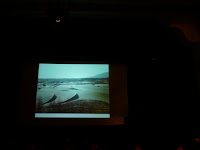NYBG Barbara Garden Lecture
Barbara Damrosch
Year Round Gardening
The second lecture in the New York Botanical Garden 2010 Lecture Series, “From the Ground Up: Gardens Re-Imagined” featured the renowned yet practical Barbara Damrosch. I love Barbara’s book, The Garden Primer. It is one of my most favorite how-to garden books.
She and her husband Eliot work a garden/farm in Maine -- Four Season Farm - with pretty much a year-round crop of vegetables.
http://www.fourseasonfarm.com
The NYBG brochure hails them as a “model of small-scale sustainable gardening.”
The popularity and seduction of Barbara’s garden style is not that it’s the Next Big Thing (hello, green walls!) but rather it’s the Last Big Thing – meaning the best thing.
Barbara’s approach to garden style is to practice the tried and true garden lessons that have served us successfully over the generations.
It is all so elegant in its simplicity.
At the same time, it’s a lot of work, no doubt. Yet, what could be more satisfying and pleasurable than to grow your own delicious, fresh food?
The bucketful of growing your own food benefits are well known: cost-effective, energy-efficient, healthful, safe, good exercise, fun, empowering, getting what you want/greater variety and so on…
But nothing beats the pure luxury of taste J
One thing that struck me about Barbara’s garden practices is how she practices “Serialized Gardening.”
This continual successive plantings and interplantings allow for more yields from even a comparatively small parcel of land or even from containers.
This continual successive plantings and interplantings allow for more yields from even a comparatively small parcel of land or even from containers.
It gives the lie to those who argue, “But I have no space to grow food.”
Or those that say, “All that work for one salad!” (I admit, in the early years of my gardening, I invested in a baby or miniature vegetable garden and that one salad did make me feel a bit silly.)
Barbara shared the fact that their garden produces approximately $80,000 worth of produce per acre. They have about 40 acres under management in what is a 3-season garden/farm. This effort and claim supports a point I’ve heard made by foodies and chefs and real farmers. I’ve heard Dan Barber, chef from Blue Hill restaurant and a James Beard award winner posit how the naysayers believe we can’t grow enough food to feed the population with smart, sustainable agriculture – well, we’re not doing that now with big corporate farms. There are people who are starving. And then there’s that pesky issue of mold, e Coli, and corn in everything. And don’t get me started on processed food…
Back to the Farm
Barbara and her family team plant in grids on a 12” x 12” or 30” beds.
She said she loves using a 29” wide rake she concocted – with red markers over the tines – to make the plant rows.
It looked like a brilliant way to make the 4-row, tick tack toe schematic for the beds
With her relaxed and confident way and with the use of big screen images, Barbara took us on a seasonal walk in her gardens. She demonstrated the succession plantings. They use cold frames and small greenhouse off the kitchen to claim fresh food even in winter. They don’t do any canning or freezing – everything is always fresh.
The pictures of the entire crew and family enjoying the bounty of the garden at mealtime would make Norman Rockwell groan… Beautiful.
She had me at fresh all year round – but if that wasn’t enough, Barbara pointed out that cultivating successively in a densely packed garden will also keep the weeds down.
At the most, once a week they use a “Culinary Hoe” that they invented and sell. It has a blade on a long handle that allows you to skim the surface of the bed without having to get in the bed. Much easier. Brilliant solution.
She also said that healthy gardens are not hospitable to “bad” insects or pathogens.
A most natural pest control occurs when the plants are healthy. Pests are attracted to gardens that are stressed. How do they know??
So short of downward facing dog, er dogwood J no yoga for the garden – just keep it healthy.
I heard this admonishment echoed at an NYBG Companion Planting class at Stone Barns recently.
Good advice.
Good advice.
Barbara had us all smiling with their most natural slug patrol: Ducks.
And they built glamorous duck digs for them, calling it, what else, “Duckingham Palace!”
Not surprisingly, Barbara rhapsodized about the glories and beauty and utility of making compost. “It makes it all work,” she claimed. “It’s the magic bullet.”
What in her compost? Mainly kitchen waste and manure. The balance is a balance of green and brown. She characterizes Brown as Fuel: straw, spent hay, leaves in moderation. Green is Nitrogen: grass clippings, kitchen waste and manure
She showed us how they build their 6-sided, wire compost bins.
Somewhat conspiratorially, she leaned in with a Secret! “Whenever the compost is empty (“How could that ever be,” I thought?!) They stick a funnel and replace with carrots or Asian greens, etc that will grow in the environment and then they restock the compost in the summer but have a crop in the meantime!
I would characterize a homegrown garden’s ability to provide a more robust, varied selection of food – an unlimited collection of even rare, or culturally exotic vegetables as another real luxury of growing a garden.
For much of the audience, it seemed one of the more interesting crops Barbara showed was frisse raised the European way – using “hats” to keep the frisse white. So cute.
Here is a picture of Chef Eberhard Mueller at his Satur Farms showing how he put frisse on the growing list, using his European background to produce one of his most favorite and delicious greens.
I took this picture last summer while we were at Satur Farms for the photo shoot for my book, "The Long Island Homegrown Cookbook," that will feature master chefs and their garden inspiration. Along with recipes and garden art and plant lists....
I took this picture last summer while we were at Satur Farms for the photo shoot for my book, "The Long Island Homegrown Cookbook," that will feature master chefs and their garden inspiration. Along with recipes and garden art and plant lists....
At Four Season Farm, they employ the use of cold frames and greenhouses to realize their fresh food even in the winter. They placed the greenhouse right outside their kitchen and pantry! Based on her husband, Eliot’s design, their moveable green houses for commercial sale. Barbara sang the praises of the Socrates cukes, peppers and eggplants grown in the greenhouse and the spectacular yields they’ve been able to achieve.
I learned a lot from Barbara’s lecture – about smart gardening practices, tools, edible landscaping and common sense, seasonal gardening tips.
I also enjoyed hearing from a gardener who sincerely loves and respects growing and eating fresh, great-tasting food.
She was also gracious enough to provide a flyer with a list of resources:
www.johnyseeds.com for seeds, cold frames, and tools designed by her husband, Eliot Coleman (and an author in his own right)
www.fedcoseeds.com
www.territorialseed.com
Companies that offer greenhouse models based on Eliot's designs but that they have no financial connection with any of them (I have to ask, "Why not?! ^:^)
www.rimolgreenhouses.com
www.fourseasontools.om
www.moveablegreenhouses.com
Barbara took a number of questions from the audience and then signed copies of her new, revised book.
Here I am with Barbara:
The book sold out that day -- but you can order here:
































